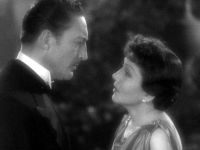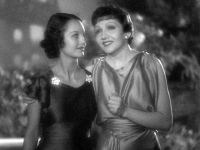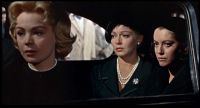Difference between pages "Concept of Authorship (Discussion)" and "Douglas Sirk as Auteur (Discussion)"
From Screenpedia
(Difference between pages)
Jump to navigationJump to search (→Thinking further about remakes: added px) |
|||
| Line 1: | Line 1: | ||
| − | == | + | ==Equivalent characters in the 1934 and 1959 versions of ''Imitation of Life''== |
| − | |||
| − | ''' | ||
| − | |||
| − | |||
| − | == | + | <table width="200" border="0"> |
| − | + | <tr> | |
| − | + | <td><strong>1934</strong></td> | |
| − | + | <td><strong>1959</strong></td> | |
| − | + | </tr> | |
| + | <tr> | ||
| + | <td>Bea</td> | ||
| + | <td>Lora</td> | ||
| + | </tr> | ||
| + | <tr> | ||
| + | <td>Delilah</td> | ||
| + | <td>Annie</td> | ||
| + | </tr> | ||
| + | <tr> | ||
| + | <td>Jessie</td> | ||
| + | <td>Susie</td> | ||
| + | </tr> | ||
| + | <tr> | ||
| + | <td>Peola</td> | ||
| + | <td>Sarah Jane</td> | ||
| + | </tr> | ||
| + | <tr> | ||
| + | <td>Steve</td> | ||
| + | <td>Steve</td> | ||
| + | </tr> | ||
| + | </table> | ||
| − | === | + | ==Readings== |
| − | + | ==="Three-Way Mirror: Imitation of Life"=== | |
| − | + | Lucy Fischer sums the previous approaches to ''Imitation of Life'' and then addresses her own concerns about the film: | |
| − | + | # "The question of women and work" | |
| − | + | # "The issue of race" | |
| − | + | # "The matter of star biography" | |
| − | '' | ||
| − | |||
| − | |||
| − | |||
| − | |||
| − | |||
| − | |||
| − | # | ||
| − | # | ||
| − | # | ||
| − | '''All Groups''' | + | Discuss these "concerns": |
| − | + | #'''All Groups:''' According to Fischer, what "cliché" is there about women's employment in the decade 1948-58? Why is it untrue? | |
| − | #*And how does | + | #'''Group 3:''' Often, films place women in the position of choosing between work outside the home and staying at home and nurturing children. How does ''Imitation of Life'' deal with this conflict—both in terms of Lora ''and'' Annie? Does Annie fit a "mammy" stereotype? What does Fischer have to say about African Americans and domestic labor? |
| − | + | #*And how does the presentation of work vs. motherhood differ in the 1934 and 1959 versions? | |
| − | + | #'''Group 4:''' It's not just work and motherhood that are inflected with issues surrounding race. Fischer also sees a connection between race and "performance," between race and imitations (plural) of life. What different forms of performance, of playing a role, are evident in ''Imitation of Life''? Who performs and why? | |
| + | #*How does changing the white mother form the "Pancake Queen" to a performer change the story's meaning? | ||
| + | #'''Grad Group:''' We'll discuss Turner as a star more fully next week, but what themes (or polysemy) does Fischer say were associated both with Turner (embodied in the Johnny Stompanato scandal) and Turner's ''character'' in ''Imitation of Life''? | ||
| − | + | ==="Distanciation and Douglas Sirk"=== | |
| − | + | #How does Sirk "intensify" elements of the melodrama genre? | |
| + | #Willemen concludes that the "distanciation effect" can be "used to parody the stylistic procedures which traditionally convey an extremely smug, self-righteous and ''petit bourgeois'' world view paramount in the American melodrama." | ||
| + | #*''Petit bourgeois'' (pronounced "petty boor-jwah") is a French word meaning, literally, the "small middle-class", but more generally referring to a conservative wocial class of shop keepers and professionals. Thus, a ''petit bourgeois'' world view is one that is politically and morally conservative. | ||
| + | #*'''Group 1:''' How might ''Imitation of Life'' be seen to be an attack on conservative values of the 1950s? Doe you think it succeeds at that? | ||
| − | == | + | ==Thinking further about remakes== |
| − | |||
| − | # | + | #'''All Groups:''' There are many differences between the two versions of ''Imitation of Life''. One subtle change is the endings. How does each film end? (Refer to [http://www.tcf.ua.edu/jbutler/Diss/AppC/index.htm frame grabs here].) How do the endings signify different resolutions of the black daughter plotline and the white mother-boyfriend-daughter plotline? |
| − | |||
| − | |||
| − | |||
| − | |||
| − | + | [[Image:ImitationOfLife1934qq01 47 59qq.jpg|left|thumb|200px|Final scene, 1934 version.]] | |
| − | + | [[Image:ImitationOfLife1934qq01 49 48qq.jpg|none|thumb|200px|Final shot, 1934 version.]] | |
| − | + | <br style="clear:both;"/> | |
| + | [[Image:ImitationOfLife1959qq02 02 53qq.jpg|left|thumb|200px|Final scene, 1959 version.]] | ||
| + | [[Image:ImitationOfLife1959qq02 03 35qq.jpg|none|thumb|200px|Final shot, 1959 version.]] | ||
| + | <br style="clear:both;"/> | ||
| − | + | ==Bibliography== | |
| + | # Lucy Fischer, "Three-Way Mirror: Imitation of Life," ''Imitation of Life: Douglas Sirk, Director'' ed. Lucy Fischer (New Brunswick, NJ: Rutgers University Press) 3-28. | ||
| + | # Paul Willemen, "Distanciation and Douglas Sirk," ''Imitation of Life: Douglas Sirk'', Director, 268-272. | ||
Revision as of 15:11, 23 April 2008
Equivalent characters in the 1934 and 1959 versions of Imitation of Life
| 1934 | 1959 |
| Bea | Lora |
| Delilah | Annie |
| Jessie | Susie |
| Peola | Sarah Jane |
| Steve | Steve |
Readings
"Three-Way Mirror: Imitation of Life"
Lucy Fischer sums the previous approaches to Imitation of Life and then addresses her own concerns about the film:
- "The question of women and work"
- "The issue of race"
- "The matter of star biography"
Discuss these "concerns":
- All Groups: According to Fischer, what "cliché" is there about women's employment in the decade 1948-58? Why is it untrue?
- Group 3: Often, films place women in the position of choosing between work outside the home and staying at home and nurturing children. How does Imitation of Life deal with this conflict—both in terms of Lora and Annie? Does Annie fit a "mammy" stereotype? What does Fischer have to say about African Americans and domestic labor?
- And how does the presentation of work vs. motherhood differ in the 1934 and 1959 versions?
- Group 4: It's not just work and motherhood that are inflected with issues surrounding race. Fischer also sees a connection between race and "performance," between race and imitations (plural) of life. What different forms of performance, of playing a role, are evident in Imitation of Life? Who performs and why?
- How does changing the white mother form the "Pancake Queen" to a performer change the story's meaning?
- Grad Group: We'll discuss Turner as a star more fully next week, but what themes (or polysemy) does Fischer say were associated both with Turner (embodied in the Johnny Stompanato scandal) and Turner's character in Imitation of Life?
"Distanciation and Douglas Sirk"
- How does Sirk "intensify" elements of the melodrama genre?
- Willemen concludes that the "distanciation effect" can be "used to parody the stylistic procedures which traditionally convey an extremely smug, self-righteous and petit bourgeois world view paramount in the American melodrama."
- Petit bourgeois (pronounced "petty boor-jwah") is a French word meaning, literally, the "small middle-class", but more generally referring to a conservative wocial class of shop keepers and professionals. Thus, a petit bourgeois world view is one that is politically and morally conservative.
- Group 1: How might Imitation of Life be seen to be an attack on conservative values of the 1950s? Doe you think it succeeds at that?
Thinking further about remakes
- All Groups: There are many differences between the two versions of Imitation of Life. One subtle change is the endings. How does each film end? (Refer to frame grabs here.) How do the endings signify different resolutions of the black daughter plotline and the white mother-boyfriend-daughter plotline?
Bibliography
- Lucy Fischer, "Three-Way Mirror: Imitation of Life," Imitation of Life: Douglas Sirk, Director ed. Lucy Fischer (New Brunswick, NJ: Rutgers University Press) 3-28.
- Paul Willemen, "Distanciation and Douglas Sirk," Imitation of Life: Douglas Sirk, Director, 268-272.



